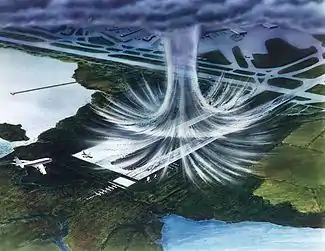Wind shear
Wind shear is a difference in either wind speed or direction over a fairly short distance in the atmosphere. Wind shear can be divided into two different types: horizontal and vertical wind shear.

NASA schematic of the downward motion of the air until it hits ground.
When wind shear is observed
Weather situations when the Wind shear is observed happen:
- At weather fronts when the temperature difference across the front is 5 °C or more, and the front moves at 15 kt or faster.
- At low level jets when a significant low level vertical wind shear can develop near the lower portion of the low level jet.
- At mountains when winds blow over and create vertical shear on the lee side.[1]
- At inversions when on a clear and calm night a radiation inversion is formed near the ground.
- At downbursts when an outflow boundary moves away from a thunderstorm.
- At sailing when wind shear affects sailboats by presenting a different wind speed and direction at different heights along the sailing mast.
Related pages
Notes
- National Center for Atmospheric Research. T-REX: Catching the Sierra’s waves and rotors Archived 2009-02-21 at the Wayback Machine Retrieved on 2006-10-21.
Other websites
Wikimedia Commons has media related to Wind shear.
- National Science Digital Library - Wind shear Archived 2005-04-20 at the Wayback Machine
This article is issued from Wikipedia. The text is licensed under Creative Commons - Attribution - Sharealike. Additional terms may apply for the media files.